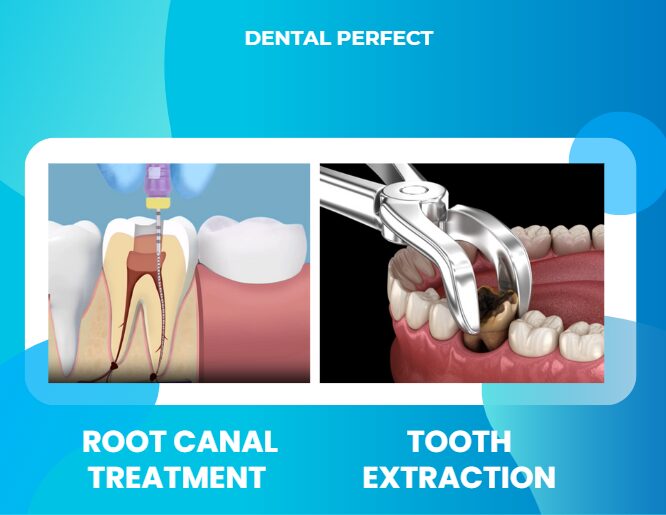When faced with a severe toothache, many patients are presented with two primary treatment options: root canal therapy or tooth extraction. While extraction might seem like the quickest solution, root canal treatment can be an effective way to save a tooth.
This guide will help you understand the differences between root canal treatment and tooth extraction, helping you make an informed decision.
Basics About Root Canal Treatment & Tooth Extraction
What is Root Canal Treatment?
Root canal treatment, also referred to as endodontic therapy, is a procedure that seeks to save a tooth that has been severely damaged or infected. The treatment includes the removal of the diseased or dead pulp inside the tooth, cleaning the interior, and sealing it to prevent future infections.
Procedure Overview
- Diagnosis: X-rays help determine the extent of infection or damage.
- Pulp Removal: Infected or dead pulp is carefully removed with barbed broaches and other tools.
- Cleaning and Shaping: Canal disinfection and shaping to allow for filling.
- Filling and Sealing: A rubber-like material is filled in the empty canal and sealed.
- Crowning: Often, a crown is placed on the tooth to strengthen and aesthetically restore the tooth.
Key Benefits
- Saves the natural structure of the tooth.
- Prevents infection to spread on surrounding teeth or mandible
- Enables it for chewing, biting, or any form of spoken words to fall into its own place.
What Is Tooth Extraction?
Alternatively, an entire tooth damaged by decay or for other causes should be fully pulled out of the socket completely, and most teeth are recommended this procedure after considering that some would not salvage this tooth as part of proper health care.
Procedure Overview
- Assessment: The dentist assesses the patient’s dental condition and explains the extraction procedure to him.
- Preparation: The area is under local anesthesia.
- Extraction: The dentist, applying surgical instruments of dental surgery, loosens and removes the tooth.
- Post-Procedure Care: The area is cleaned, and stitches may be applied where needed.
Key Benefits
- Eliminates pain and infections immediately.
- Avoids other complications that would happen in the case of shattered, bad teeth.
- Allows for tooth replacement options, such as bridges or implants, when necessary.
Root Canal vs. Extraction
| Aspect | Root Canal Treatment | tooth Extraction |
| Pain and Discomfort | Generally less painful during and after the procedure compared to extraction. | Often more painful, with a longer recovery period. |
| Appearance | Retains the natural tooth, preserving a natural appearance. | Leaves a gap unless replaced by an implant, bridge, or denture. |
| Impact on Surrounding Teeth | Maintains proper alignment and spacing of teeth. | Adjacent teeth may shift, potentially leading to alignment issues. |
| Complications | Lower risk of complications, as it avoids foreign objects like implants. | Risk of complications like a dry socket or implant rejection if a replacement is placed. |
| Cost | Typically less expensive than the combined cost of extraction and replacement with a prosthetic. | More expensive if follow-up treatments like implants or bridges are needed. |
| Treatment Duration | Requires fewer visits, often completed in one or two appointments. | It may require multiple procedures (e.g., bone grafts, implants) to address the gap left by the missing tooth. |
| Functionality | Restores full function for biting and chewing. | Prosthetic replacements may not replicate the exact function and feel of a natural tooth. |
| Indications | Suitable for saving teeth with severe decay or infection but still salvageable. | Necessary for teeth too damaged to save or for overcrowding |
| Longevity | It can last a lifetime if properly maintained with good oral hygiene. | Replacement options (e.g., implants, bridges) may require maintenance or replacement over time. |
Why Choose Root Canal Treatment Over Extraction?
Preserving your natural tooth through root canal treatment offers significant long-term benefits over extraction. Natural teeth provide better functionality, aesthetic appearance, and support for facial structure. They help maintain proper alignment and prevent neighboring teeth from shifting.
Additionally, root canal treatment is more cost-effective in the long run, as it reduces the need for future replacements or additional procedures. Advances in dental technology have made root canal procedures highly successful with fewer complications than extractions.
Saving Your Natural Teeth is Worth It
Choosing to save your natural teeth is a proactive decision that ensures long-term oral health, improved quality of life, and better aesthetics. Although root canal treatments might appear more expensive upfront, they often prove to be more cost-efficient compared to tooth extractions and subsequent replacements.
At Dental Perfect, we are committed to providing high-quality dental equipment for all types of procedures, from root canals to extractions. Our advanced tools, including barbed broaches and specialized instruments, support dentists in delivering exceptional care to patients.
Visit Dental Perfect to explore our full range of dental instruments designed for precision, safety, and durability.






























